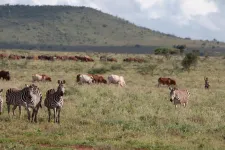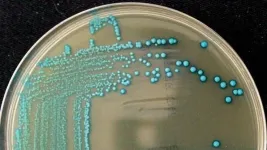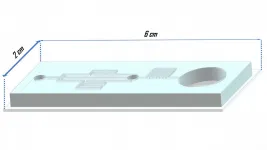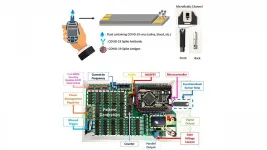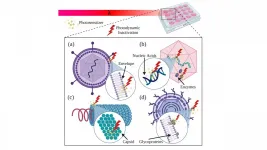INFORMATION:
The paper's co-authors are Hassell, Global Health Program, SCBI and Department of Epidemiology of Microbial Disease, Yale School of Public Health; Tim Newbold, Centre for Biodiversity & Environment Research, Department of Genetics, Evolution and Environment, University College London; Andrew P. Dobson, Department of Ecology & Evolutionary Biology, Princeton University and Santa Fe Institute; Linton, doctorate in zoology, Walter Reed Biosystematics Unit, Smithsonian's Museum Support Center, Department of Entomology, Smithsonian's National Museum of Natural History and Walter Reed Army Institute of Research; Lydia H.V. Franklinos, Centre for Biodiversity & Environment Research, Department of Genetics, Evolution and Environment, University College London; Dr. Dawn Zimmerman, veterinarian, Global Health Program, SCBI and Department of Epidemiology of Microbial Disease, Yale School of Public Health; and Pagenkopp Lohan, doctorate in marine science, Marine Disease Ecology Laboratory, Smithsonian Environmental Research Center.
New model for infectious disease could better predict future pandemics
Potential benefits to health across species, communities and environments are enormous
2021-05-18
(Press-News.org) In the midst of a devastating global pandemic of wildlife origin and with future spillovers imminent as humans continue to come into closer contact with wildlife, infectious-disease models that consider the full ecological and anthropological contexts of disease transmission are critical to the health of all life. Existing models are limited in their ability to predict disease emergence, since they rarely consider the dynamics of the hosts and ecosystems from which pandemics emerge.
Published May 17 in Nature Ecology and Evolution, Smithsonian scientists and partners provide a framework for a new approach to modeling infectious diseases. It adapts established methods developed to study the planet's natural systems, including climate change, ocean circulation and forest growth, and applies them to parasites and pathogens that cause disease.
Increased human-animal interactions lead to the emergence and spread of zoonotic pathogens, which cause about 75% of infectious diseases affecting human health. Predicting where, how and when people and animals are at risk from emerging pathogens--and the best ways to manage this--remains a significant challenge. Risks for spillover include, but are not limited to, habitat encroachment, illegal wildlife trade and bush meat consumption.
Despite incredible advances in the understanding of how infectious diseases are transmitted, the models these efforts are based on are relatively limited in scope, focusing on specific pathogens and often overlooking how pathogens interact within their hosts. While scientists and global health organizations are putting a lot of effort into studying the diversity of disease-causing organisms, existing models do not link this diversity to their roles within ecosystems.
"Just as a mechanic must understand how a car's components interact and how it's been engineered in order to improve performance, the same applies to our ability to model infectious disease," said first author Dr. James Hassell, wildlife veterinarian, epidemiologist and Keller Family Skorton Scholar for the Smithsonian Conservation Biology Institute's (SCBI) Global Health Program. "Applying systems-level thinking to forecast disease emergence requires a fundamental change in how we conceptualize infectious diseases. This presents significant challenges, but in this article, we explain why they're not insurmountable. When you weigh the cost of prevention versus remediation, the investment in our shared global health, particularly the connections between nature and human health, is vital."
Researchers say this new model will require expertise and collaboration across fields such as veterinary and human medicine, disease ecology, biodiversity conservation, biotechnology and anthropology.
"Disease and health are predominantly viewed as a human construct and the role the environment plays in disease is often overlooked," said Yvonne-Marie Linton, research director for the Walter Reed Biosystematics Unit for the Smithsonian's National Museum of Natural History and Walter Reed Army Institute of Research. "The health of other organisms, from parasites and insects to birds and aquatic organisms, can alter the structure of ecosystems. What we're proposing is a new approach to modeling infectious diseases that are circulating in nature, which would allow scientists to simulate the behavior of these pathogens in wildlife populations, how they respond to human activities and better determine the risk that they pose to people."
General ecosystem models are essentially complex models that can predict how food chains are assembled--the processes of energy transfer between plants and animals are what structure ecosystems--and determine the plants and animals that compose an ecosystem. With the new version, general "episystem" models, the paper's authors outline a framework for integrating disease agents (including parasites, viruses and bacteria) into these models. By identifying general rules for how food chains that include disease entities are structured, it should be possible to predict the types of pathogens that are present in any given ecosystem. This would allow scientists to better understand the characteristics of an ecosystem (such as disturbance) that would make it more likely to contain zoonotic pathogens, predict the threat it poses to people who interact with this ecosystem and even permit computer simulation and testing of interventions aimed at reducing these threats.
While the amount of data that would be required to create these models is daunting, long-term studies of intact ecosystems where parasite data has been collected are excellent places to initiate these studies. Efforts to refine them more broadly could then leverage large-scale ecological studies that span continents such as the Smithsonian's ForestGEO and MarineGEO programs.
The potential impacts of this new model go beyond reducing the human interface for disease spillover, to economics. "You could use this new approach to not only to look at human diseases, but also to look at the best way to conduct aquaculture or raise healthy livestock," said Katrina M. Pagenkopp Lohan, a marine disease ecologist at the Smithsonian Environmental Research Center. "If you're reintroducing a species into the wild, what do you need that ecosystem to look like for you to be successful? We could actually model that. It's mind blowing."
The cost of such a new approach is considerable, say researchers, and will take the global cooperation and commitment of scientists, communities, non-governmental organizations and nations. In an era of big data and massive advances in technology, this kind of approach is achievable but requires enhanced data collection, sharing and testing at far greater scales than currently occur.
ELSE PRESS RELEASES FROM THIS DATE:
Salk scientists reveal role of genetic switch in pigmentation and melanoma
2021-05-18
LA JOLLA--(MAY 18, 2021) Despite only accounting for about 1 percent of skin cancers, melanoma causes the majority of skin cancer-related deaths. While treatments for this serious disease do exist, these drugs can vary in effectiveness depending on the individual.
A Salk study published on May 18, 2021, in the journal Cell Reports reveals new insights about a protein called CRTC3, a genetic switch that could potentially be targeted to develop new treatments for melanoma by keeping the switch turned off.
"We've been able to correlate the activity of this genetic switch to melanin production and cancer," says Salk study ...
Study finds potential causality between blood clot factors and migraine with aura
2021-05-18
Nearly 15 percent of the U.S. population experiences migraine. One subtype of migraine that is not well understood is migraine with aura (MA). Individuals who experience MA often see flashing lights, blind spots, or jagged lines in their visual field prior to onset of their migraine headaches. Individuals who experience MA also face a heightened risk of stroke and cardiovascular disease, although scientists continue to explore why this correlation exists. In a new study from Brigham and Women's Hospital, researchers used a technique in genetic analysis termed Mendelian randomization to examine 12 coagulation measures, uncovering four that are associated ...
Novel simulation method predicts blood flow conditions behind von Willebrand disease
2021-05-18
For the first time, researchers can quantitatively predict blood flow conditions that likely cause pathological behavior of the human blood protein von Willebrand factor (vWF). Predictions from this new method of simulation, developed at Lehigh University, can be used to optimize the design of the mechanical pumps known as left ventricular assist devices used in heart failure patients. The method also has the potential to improve diagnosis and treatment of von Willebrand disease, the most common inherited bleeding disorder in the U.S., according to the Centers for Disease Control and Prevention. The article, "Predicting pathological von Willebrand factor unraveling in elongational flow," appears ...
Ancient horse DNA reveals gene flow between Eurasian and North American horses
2021-05-18
A new study of ancient DNA from horse fossils found in North America and Eurasia shows that horse populations on the two continents remained connected through the Bering Land Bridge, moving back and forth and interbreeding multiple times over hundreds of thousands of years.
The new findings demonstrate the genetic continuity between the horses that died out in North America at the end of the last ice age and the horses that were eventually domesticated in Eurasia and later reintroduced to North America by Europeans. The study has been accepted for publication in the journal Molecular Ecology and is currently available ...
Scientists discover five new species of listeria, improving food safety
2021-05-18
ITHACA, N.Y. - While examining the prevalence of listeria in agricultural soil throughout the U.S., Cornell University food scientists have stumbled upon five previously unknown and novel relatives of the bacteria.
The discovery, researchers said, will help food facilities identify potential growth niches that until now, may have been overlooked - thus improving food safety.
"This research increases the set of listeria species monitored in food production environments," said lead author Catharine R. Carlin, a doctoral student in food science. "Expanding the knowledge base to understand the diversity of listeria will save the commercial food world confusion and errors, as well as prevent ...
Embryo cryopreservation minimizes cryoinjuries, offers hope for would-be parents
2021-05-18
WASHINGTON, May 18, 2021 -- What are the most delicate and valuable things you have handled? How would you feel if your daily job involved handling human eggs and any mistakes would affect someone's life?
Typical egg collection requires a healthy woman to go through weeks of hormone therapy and then undergo an operation to retrieve eggs. These hard-earned and precious eggs are fertilized in vitro, and the best embryos are selected for future transfer.
But not all transfers succeed, which gives rise to the practice of freezing the extra embryos from an IVF cycle for future ...
COVID-19 testing method gives results within one second
2021-05-18
WASHINGTON, May 18, 2021 -- The COVID-19 pandemic made it clear technological innovations were urgently needed to detect, treat, and prevent the SARS-CoV-2 virus. A year and a half into this epidemic, waves of successive outbreaks and the dire need for new medical solutions -- especially testing -- continue to exist.
In the Journal of Vacuum Science & Technology B, researchers from the University of Florida and Taiwan's National Chiao Tung University report a rapid and sensitive testing method for COVID-19 biomarkers.
The researchers, who previously demonstrated ...
Adding antibodies to enhance photodynamic therapy for viral and bacterial disease
2021-05-18
WASHINGTON, May 18, 2021 -- The COVID-19 pandemic has reinforced the pressing need to mitigate a fast-developing virus as well as antibiotic-resistant bacteria that are growing at alarming rates worldwide.
Photodynamic therapy (PDT), or using light to inactivate viruses, bacteria, and other microbes, has garnered promising results in recent decades for treating respiratory tract infections, such as pneumonia, and some types of cancer.
In Applied Physics Reviews, by AIP Publishing, researchers at Texas A&M University and the University of São Paulo in Brazil ...
Disabled researcher calls for better support for faculty
2021-05-18
Academic institutions need to do much more to support faculty members with disabilities and to create an environment in which they can thrive, argues a commentary published May 18 in the journal Trends in Neurosciences. The paper was written by Justin Yerbury, a cell and molecular neurobiologist who has amyotrophic lateral sclerosis (ALS), and his wife, Rachel Yerbury, a research psychologist.
"We want people to understand how tough life is for people with a disability," says Justin Yerbury (@jjyerbury), a professor at the University of Wollongong in Australia. "When you add academia on top of ...
Hepatitis C screening doubles when tests ordered ahead of time
2021-05-18
Twice as many eligible patients got screened for hepatitis C when it was already ordered for them compared to those who had to request it, according to a new study by researchers at the Perelman School of Medicine at the University of Pennsylvania. Additionally, the patients in the study - whose average age was 63 - completed their screenings much more often when they were contacted via mail as opposed to electronic messaging. The study was published today in BMJ.
"We think that sending the lab order with outreach was so successful because it ...
LAST 30 PRESS RELEASES:
Layered hydrogen silicane for safe, lightweight, and energy-efficient hydrogen carrier
Observing positronium beam as a quantum matter wave for the first time
IEEE study investigates the effects of pointing error on quantum key distribution systems
Analyzing submerged fault structures to predict future earthquakes in Türkiye
Quantum ‘alchemy’ made feasible with excitons
‘Revoice’ device gives stroke patients their voice back
USF-led study: AI helps reveal global surge in floating algae
New method predicts asthma attacks up to five years in advance
Researchers publish first ever structural engineering manual for bamboo
National poll: Less than half of parents say swearing is never OK for kids
Decades of suffering: Long-term mental health outcomes of Kurdish chemical gas attacks
Interactional dynamics of self-assessment and advice in peer reflection on microteaching
When aging affects the young: Revealing the weight of caregiving on teenagers
Can Canada’s health systems handle increased demand during FIFA World Cup?
Autistic and non-autistic faces may “speak a different language” when expressing emotion
No clear evidence that cannabis-based medicines relieve chronic nerve pain
Pioneering second-order nonlinear vibrational nanoscopy for interfacial molecular systems beyond the diffraction limit
Bottleneck in hydrogen distribution jeopardises billions in clean energy
Lung cancer death rates among women in Europe are finally levelling off
Scientists trace microplastics in fertilizer from fields to the beach
The Lancet Obstetrics, Gynecology, & Women’s Health: Taking paracetamol during pregnancy does not increase risk of autism, ADHD or intellectual disabilities, confirms new gold-standard evidence review
Taking paracetamol during pregnancy does not increase risk of autism, ADHD or intellectual disabilities
Harm reduction vending machines in New York State expand access to overdose treatment and drug test strips, UB studies confirm
University of Phoenix releases white paper on Credit for Prior Learning as a catalyst for internal mobility and retention
Canada losing track of salmon health as climate and industrial threats mount
Molecular sieve-confined Pt-FeOx catalysts achieve highly efficient reversible hydrogen cycle of methylcyclohexane-toluene
Investment in farm productivity tools key to reducing greenhouse gas
New review highlights electrochemical pathways to recover uranium from wastewater and seawater
Hidden pollutants in shale gas development raise environmental concerns, new review finds
Discarded cigarette butts transformed into high performance energy storage materials
[Press-News.org] New model for infectious disease could better predict future pandemicsPotential benefits to health across species, communities and environments are enormous
